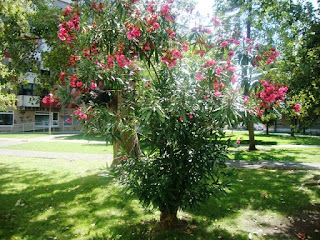"I start by asking participants who they are and why they want to spend precious hours looking at trees. My students are nearly all highly educated, successful people who work impressive jobs, speak multiple languages and effortlessly command sophisticated computers and phones. Yet most know barely the first thing about the trees around them. They want to change that.
There was a time when knowing your trees was a matter of life and death, because you needed to know which ones were strong enough to support a house and which ones would feed you through the winter. Now most of us walk around, to adapt a term devised by some botanists, tree blind."
Here are some of my most recent tree classifications around me:
Indian Rubber-Tree (English)/ Borracheira (Português)/ Ficus elastica (Latin)
Here are some of my most recent tree classifications around me:
Indian Rubber-Tree (English)/ Borracheira (Português)/ Ficus elastica (Latin)
This tree has wide, smooth leaves with unbroken edges. My book says it is usually grown as a pot plant, but we have two of them in the little park behind our house and they are taaaaaall. Addie calls it her "climbing tree".
Strawberry-tree / Medronheiro / Arbutus unedo
I was expecting bigger berries from the picture in my book, but they're actually pretty small. This is a small tree or shrub with a funny name, because the berries don't look like strawberries at all.
Oleander / Loendro / Nerium oleander
Oleander / Loendro / Nerium oleander
So here is a perfect example of why it was important 100 years ago to know about trees and plants for your survival (like the article says, which wood to build your house with, which berries to eat) and even nowadays. This is a highly popular shrub in Portugal, in the park behind our house, in playgrounds, lining highways, and IT IS POISONOUS. Wikipedia says if you put it in your mouth you could get extremely sick or DIE. I just think of my 14-month-old and this knowledge I only have now and think, HOLY SMOKES! My husband used to alwas pick one of these flowers with Addie to give to me when they would come home from some walk. So watch out for this shrub with pointy leaves and flowers.
Olive / Oliveira Brava / Olea europaea
Olive / Oliveira Brava / Olea europaea
A classic olive tree, also so common in Portugal, that is easy to classify (NOW, that I'm looking for that) because of its olives, of course. It is small, sometimes a shrub and has a gray, twisted trunk.
Cottonwood / Algodão Americano / Populus deltoides
Cottonwood / Algodão Americano / Populus deltoides
My neighbor helped me out with this tree, because it is everywhere and I couldn't figure out for the life of me what it was. She remembered that they had been "snowing on us" in the Spring at a park we usually go to. Cottonwoods! What an appropriate name for a tree that "snows" cotton-like catkins. These are very tall trees with a fissured, grayish bark and heart-shaped leaves.










No comments:
Post a Comment